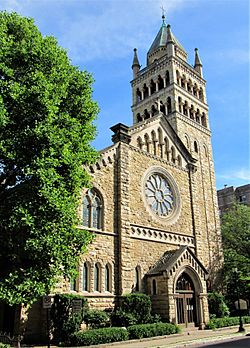St. Stephen's Episcopal Pro-Cathedral (Wilkes-Barre, Pennsylvania) facts for kids
Quick facts for kids St. Stephen's Pro-Cathedral |
|
|---|---|
 |
|
| 41°14′48″N 75°53′04″W / 41.24653°N 75.88439°W | |
| Location | 35 S. Franklin St. Wilkes-Barre, Pennsylvania |
| Country | United States |
| Denomination | Episcopal Church in the United States of America |
| History | |
| Founded | 1817 |
| Architecture | |
| Architect(s) | Charles M. Burns |
| Style | Romanesque Revival |
| Completed | 1897 |
| Specifications | |
| Number of spires | One |
| Administration | |
| Diocese | Bethlehem |
St. Stephen's Episcopal Pro-Cathedral is an important church in Wilkes-Barre, Pennsylvania. It is part of the Episcopal Church in the United States of America. This church serves as a "Pro-Cathedral" for the Episcopal Diocese of Bethlehem. A Pro-Cathedral is a church that acts like a main cathedral, but it's not the official one. The main cathedral for this area is the Cathedral Church of the Nativity in Bethlehem, Pennsylvania.
History of St. Stephen's
The St. Stephen's Church community started a long time ago in 1817. Over the years, they built several churches. The building you see today is the fifth one for this church group.
Building the Current Church
Construction on the current church building finished in 1897. It was officially dedicated in 1899. A famous architect from Philadelphia, Pennsylvania, Charles M. Burns, designed the church. He used a style called Romanesque Revival architecture. This style often features round arches and strong, solid-looking walls.


